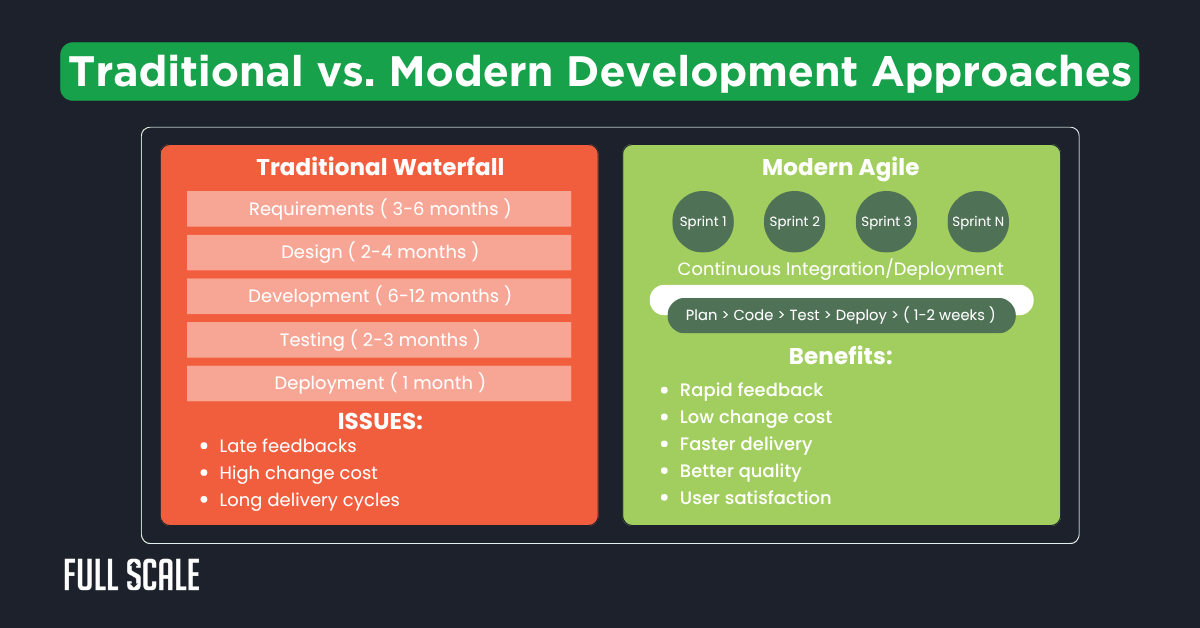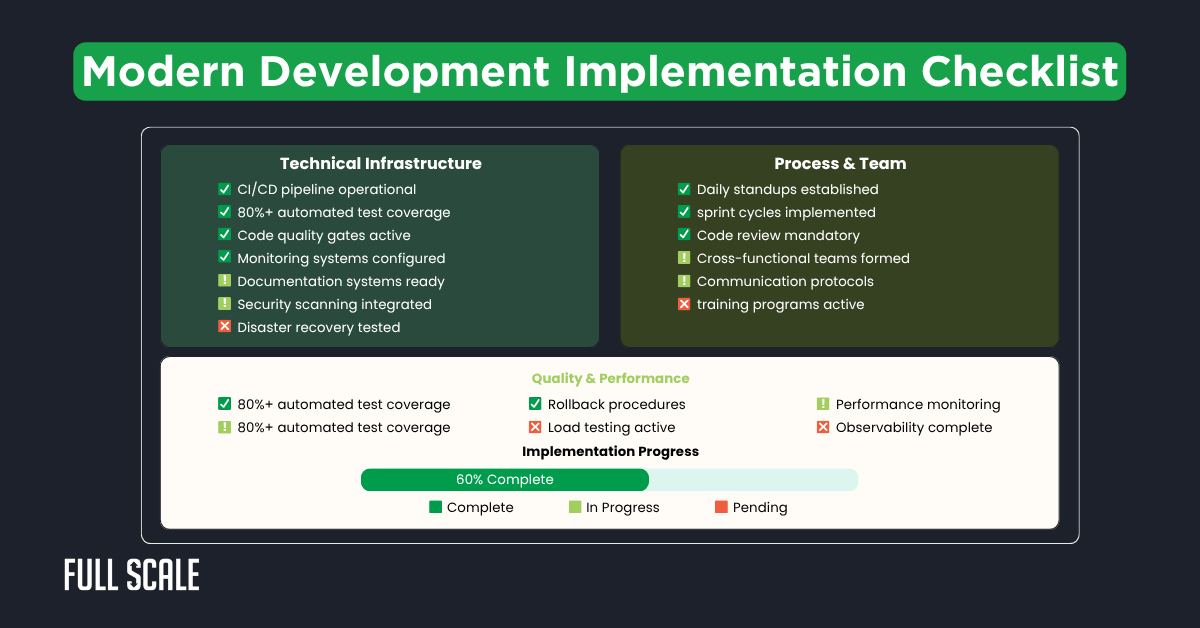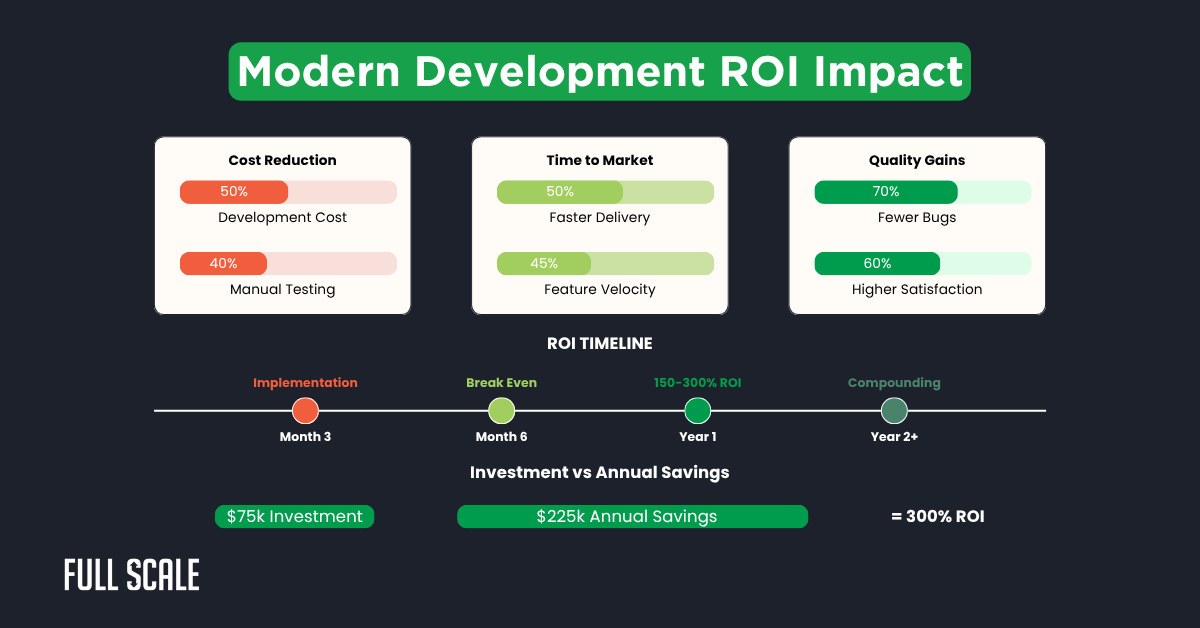Last Updated on 2025-06-23
While 68% of software projects still fail to meet their original time and budget estimates according to the latest 2024 PMI Pulse Report, leading tech companies like Netflix, Spotify, and Amazon consistently deliver high-quality products faster than ever
According to the 2024 State of DevOps Report, elite performers deploy code 973 times more frequently than low performers while maintaining superior quality. What separates these industry leaders from the struggling majority is their adoption of modern software development processes.
The pressure to deliver faster without sacrificing quality has never been greater. This comprehensive guide reveals the complete framework that top companies use to achieve three times faster delivery times while maintaining quality through the modern software development process implementation.
What Makes Modern Software Development Different?
Modern software development represents a fundamental shift from traditional approaches. The transformation affects every aspect of how teams plan, build, and deliver software products through agile development methodology and continuous integration and continuous deployment practices.

The 5 Core Pillars of Modern Software Development Process
Modern software development rests on five fundamental pillars that enable software development cost optimization:
- Agile Methodology Integration: Short iterations replace lengthy planning cycles through proven software development strategies
- DevOps and CI/CD: Automated deployment pipelines replace manual processes, enabling continuous integration and continuous deployment
- Cloud-Native Development: Microservices architecture enables independent scaling and deployment
- Quality-First Automation: Automated testing strategies shift quality assurance left in the process
- Cross-Functional Team Collaboration: Software development team structure evolves to support seamless collaboration
The 7 Stages of the Modern Software Development Process
Understanding the steps of the development process for a software project helps teams implement effective workflows:
Stage 1: Strategic Planning and Requirements Analysis
- User story mapping replaces traditional requirements documentation
- Stakeholder alignment workshops reduce project failures by 40%
- Tools: Jira, Confluence, Miro, Slack
Stage 2: Architecture and Technical Design
- Microservices architecture enables independent development
- API-first development ensures system interoperability
- Tools: Draw.io, Lucidchart, Postman, Swagger
Stage 3: Development and Implementation
- Feature-driven development breaks work into manageable pieces
- Pair programming improves code quality and knowledge sharing
- Tools: Git, GitHub/GitLab, VS Code, ESLint
Stage 4: Continuous Testing and Quality Assurance
- Test-driven development ensures comprehensive coverage
- Automated testing strategies reduce production bugs by 60%
- Tools: Jest, Selenium, Cypress, SonarQube
Stage 5: Deployment and Release Management
- Blue-green deployments eliminate downtime during releases
- Feature flags enable gradual rollouts and A/B testing
- Tools: Docker, Kubernetes, Jenkins, AWS/Azure
Stage 6: Monitoring and Maintenance
- Application Performance Monitoring tracks system health
- Real-time alerts prevent user-facing issues
- Tools: New Relic, Datadog, Splunk, Grafana
Stage 7: Continuous Improvement and Iteration
- Retrospectives drive incremental process enhancements
- Metrics-driven decisions align improvements with business objectives
- Tools: Amplitude, Mixpanel, Hotjar, Google Analytics
Industry Best Practices for Software Development Teams
Leading technology companies have refined their modern software development processes through years of iteration and experimentation. Their proven approaches provide actionable templates that other organizations can adapt and implement. Studying these real-world examples reveals common patterns that drive exceptional results.
Netflix: Microservices at Scale
- Challenge: Scale streaming platform for 230+ million users globally
- Solution: 700+ microservices with chaos engineering
- Results: 99.99% uptime, thousands of daily deployments
Key Lessons:
- Embrace failure as a learning opportunity
- Invest in observability and monitoring
- Automate everything to reduce human error
Spotify: Autonomous Team Structure
- Challenge: Maintain agility with 4,000+ employees
- Solution: Squad, tribe, chapter model
- Results: 10x faster feature delivery than industry average
Organizational Structure:
- Squads: 6-12 people with full autonomy
- Tribes: Collection of squads in the same business area
- Chapters: Similar skills across squads
- Guilds: Communities spanning the entire organization
Amazon: API-First Architecture
- Challenge: Scale engineering without coordination bottlenecks
- Solution: Two-pizza teams with service-oriented architecture
- Results: Deploy every 11.7 seconds across all services
Key Principles:
- Limit team sizes for communication efficiency
- Full service ownership from development to operations
- No shared databases or direct dependencies
Modern Software Development Tools and Techniques
Tool selection significantly impacts team productivity and the effectiveness of modern software development processes. The right toolchain enables automation, collaboration, and quality assurance at scale. This comparison helps teams choose appropriate solutions for their specific requirements and constraints.
| Category | Tool | Best For | Cost | Team Size |
| Version Control | Git + GitHub | All teams | Free-$4/user | Any |
| CI/CD | GitHub Actions | Startups | Free-$0.008/min | Any |
| CI/CD | Jenkins | Enterprise | Free (hosting) | 20+ |
| Testing | Jest + Cypress | JavaScript | Free | Any |
| Monitoring | New Relic | APM | $25-750/month | 5+ |
| Project Management | Jira | Enterprise | $7.50-14.50/user | 10+ |
Recommended Tech Stacks by Industry
FinTech Software Development:
- Frontend: React.js with TypeScript
- Backend: Node.js with Express.js
- Database: PostgreSQL for ACID compliance
- Infrastructure: AWS with SOC 2 compliance
HealthTech Development Process:
- Frontend: React.js with secure authentication
- Backend: Python Django for security
- Database: PostgreSQL with encryption
- Integration: HL7 FHIR for data exchange
Enterprise Software Development:
- Frontend: Angular for large-scale apps
- Backend: Java Spring Boot
- Database: Oracle/SQL Server
- Infrastructure: Private/hybrid cloud
How to Improve Software Development Speed
Accelerating development velocity requires systematic measurement and optimization of key performance indicators. Teams must balance speed with quality to achieve sustainable improvements in their modern software development process. The following metrics framework enables data-driven decisions that enhance both efficiency and outcomes.
Essential Development Metrics
Velocity Metrics:
- Lead time for changes: Code commit to production
- Deployment frequency: Release cadence to production
- Feature delivery rate: Completed features per sprint
Quality Metrics:
- Bug detection rate: Issues found before production
- Code coverage percentage: Automated test coverage
- Customer satisfaction scores: User feedback ratings
Efficiency Metrics:
- Cost per feature: Development expense per deliverable
- Developer productivity index: Output per team member
- Time to market: Concept to user availability
ROI of Modern Development Processes
Measuring the financial impact of modern software development process implementation is crucial for stakeholder buy-in. Organizations typically see measurable returns within 6 months of implementation. The following metrics demonstrate typical improvements across cost, time, and quality dimensions.

Cost Reductions:
- Development costs: 30-50% reduction
- Manual testing: 40% time savings
- Deployment errors: 60% fewer issues
Time Improvements:
- Faster delivery: 40-60% acceleration
- Feature velocity: 45% increase
- Market responsiveness: 3x improvement
Quality Gains:
- Production bugs: 70% reduction
- Customer satisfaction: 60% improvement
- System reliability: 99.9%+ uptime
Implementation Framework
Successful transformation to modern software development processes requires a structured, phased approach. This proven framework reduces implementation risks while delivering measurable improvements at each stage. Teams can adapt timelines based on their specific constraints and organizational requirements.
Phase 1: Assessment (Weeks 1-2)
- Document existing workflows and practices
- Identify bottlenecks in current processes
- Evaluate team skills and tool capabilities
- Define success metrics and targets
Phase 2: Foundation (Weeks 3-6)
- Implement CI/CD pipeline infrastructure
- Establish automated testing frameworks
- Set up code quality standards
- Create documentation systems
Phase 3: Team Transformation (Weeks 7-10)
- Train teams on agile methodologies
- Form cross-functional teams
- Establish communication protocols
- Begin upskilling programs
Phase 4: Optimization (Weeks 11-14)
- Monitor key performance indicators
- Identify and resolve bottlenecks
- Implement continuous improvement processes
- Gather stakeholder feedback

Overcoming Common Implementation Challenges
Every organization faces predictable obstacles when transitioning to modern software development processes. Understanding these challenges beforehand enables proactive planning and faster adoption. The following strategies address the most common barriers to successful transformation.
Challenge 1: Resistance to Change
Solutions:
- Identify early adopters as champions
- Implement changes gradually
- Invest in comprehensive training
- Communicate early wins and progress
Timeline: 3-6 months for full adoption
Challenge 2: Legacy System Integration
Solutions:
- Apply the Strangler Fig Pattern for gradual replacement
- Create API wrappers around legacy systems
- Plan systematic data modernization
- Update systems incrementally
Timeline: 6-12 months for complete modernization
Challenge 3: Skill Gap Management
Solutions:
- Provide targeted training on modern practices
- Create mentorship programs
- Add experienced team members strategically
- Engage external consultants for guidance
Timeline: 2-4 months for basic upskilling
Future Trends in Software Development
The software development landscape continues evolving rapidly with emerging technologies and methodologies. Staying ahead of these trends helps teams maintain competitive advantages and prepare for future challenges. Early adoption of relevant innovations can significantly impact development efficiency and product quality.
Emerging Technologies
- AI-Assisted Development: GitHub Copilot accelerates coding
- Low-Code Integration: Citizen developers build applications faster
- Edge Computing: Distributed processing reduces latency
- Quantum-Resistant Security: Preparing for quantum computing impact
Process Evolution
- Continuous Everything: Expanding beyond CI/CD to all processes
- Platform Engineering: Internal developer platforms simplify operations
- Observability-Driven Development: Building monitoring into applications
Transform Your Development Process Today
The modern software development process represents a fundamental shift that enables organizations to deliver products faster while maintaining quality. Companies that implement these proven software development strategies achieve measurable improvements in velocity, quality, and cost efficiency.
Key Takeaways
- Speed and quality are not mutually exclusive through modern practices
- Process improvements reduce costs while enhancing outcomes
- Top companies share common patterns across different contexts
- Strategic implementation delivers sustainable competitive advantages
Immediate Next Steps
- Assess current development maturity and identify improvement opportunities
- Identify biggest process bottleneck limiting team effectiveness
- Start with CI/CD pipeline implementation for immediate benefits
- Invest in team training to enable technology adoption
Ready to Accelerate Your Development?
Outdated development processes limit company growth and competitiveness. Organizations using traditional approaches fall behind more agile competitors who have embraced modern software development processes.
Full Scale has helped hundreds of companies implement modern software development processes that deliver measurable results. Our expert remote developers understand both technical and cultural transformation aspects. We provide proven methodologies that reduce implementation risks while accelerating benefits.
Transform your development process with expert remote developers who understand modern practices and can help you achieve 3x faster delivery while reducing costs by up to 50%.
Explore Our Remote Development Services
FAQs: The Modern Software Development Process
What is the modern software development process?
The modern software development process combines agile development methodology with continuous integration and continuous deployment practices. It emphasizes iterative development cycles, automated testing strategies, and cross-functional team collaboration to deliver software faster while maintaining quality.
How long does it take to implement modern software development processes?
Implementation timeline varies by organization size and complexity:
- Assessment and planning: 1-2 weeks
- Foundation setup: 3-6 weeks
- Team transformation: 7-10 weeks
- Process optimization: 11-14 weeks
Most organizations see initial benefits within 3 months and full ROI within 12 months.
What are the best practices for software development teams transitioning to modern processes?
Key best practices for software development teams include:
- Start with CI/CD pipeline implementation for immediate automation benefits
- Invest in automated testing strategies to ensure quality throughout development
- Form cross-functional teams around product features rather than technical roles
- Implement daily standups and sprint planning for better communication
- Focus on software development cost optimization through process improvements
How can companies improve software development speed without sacrificing quality?
Companies can improve software development speed through modern practices:
- Automated testing: Catch bugs early in the development lifecycle
- DevOps implementation: Streamline deployment and infrastructure management
- Microservices architecture: Enable parallel development and independent scaling
- Feature flags: Deploy code safely and enable gradual rollouts
- Continuous monitoring: Identify and resolve issues proactively
How does FullScale help companies implement modern software development processes?
FullScale provides expert remote developers who specialize in modern software development processes and proven software development strategies. Our services include:
- Team augmentation: Add experienced developers familiar with modern practices
- Process consultation: Guide the implementation of agile development methodology and CI/CD
- Technology expertise: Support cloud-native development and microservices architecture
- Cultural transformation: Help teams adapt to cross-functional collaboration models
We help companies achieve 3x faster delivery while reducing development costs by up to 50%.

Matt Watson is a serial tech entrepreneur who has started four companies and had a nine-figure exit. He was the founder and CTO of VinSolutions, the #1 CRM software used in today’s automotive industry. He has over twenty years of experience working as a tech CTO and building cutting-edge SaaS solutions.
As the CEO of Full Scale, he has helped over 100 tech companies build their software services and development teams. Full Scale specializes in helping tech companies grow by augmenting their in-house teams with software development talent from the Philippines.
Matt hosts Startup Hustle, a top podcast about entrepreneurship with over 6 million downloads. He has a wealth of knowledge about startups and business from his personal experience and from interviewing hundreds of other entrepreneurs.




